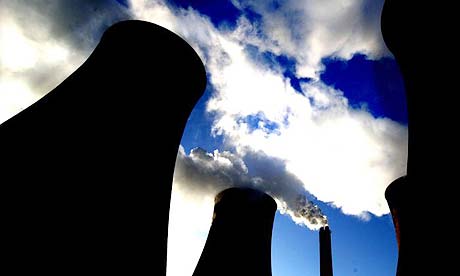- David Adam, environment correspondent

Cooling towers at Eggborough power station, near Selby. Photograph: John Giles/PA
The concentration of carbon dioxide in the atmosphere has reached a record high, according to the latest figures, renewing fears that climate change could begin to slide out of control.
Scientists at the Mauna Loa observatory in Hawaii say that CO2 levels in the atmosphere now stand at 387 parts per million (ppm), up almost 40% since the industrial revolution and the highest for at least the last 650,000 years.
The figures, published by the US National Oceanic and Atmospheric Administration on its website, also confirm that carbon dioxide, the chief greenhouse gas, is accumulating in the atmosphere faster than expected. The annual mean growth rate for 2007 was 2.14ppm - the fourth year in the last six to see an annual rise greater than 2ppm. From 1970 to 2000, the concentration rose by about 1.5ppm each year, but since 2000 the annual rise has leapt to an average 2.1ppm.
Scientists say the shift could indicate that the Earth is losing its natural ability to soak up billions of tonnes of CO2 each year. Climate models assume that about half our future emissions will be reabsorbed by forests and oceans, but the new figures confirm this may be too optimistic. If more of our carbon pollution stays in the atmosphere, it means emissions will have to be cut by more than is currently projected to prevent dangerous levels of global warming.
Martin Parry, co-chair of the Intergovernmental Panel on Climate Change's working group on impacts, said: "Despite all the talk, the situation is getting worse. Levels of greenhouse gases continue to rise in the atmosphere and the rate of that rise is accelerating. We are already seeing the impacts of climate change and the scale of those impacts will also accelerate, until we decide to do something about it."
Perched some 11,000ft up a volcano, the Mauna Loa observatory has been measuring carbon dioxide in the atmosphere since 1958. It is regarded as producing among the most reliable data sets because of its remote location, far from any possible source of the gas that could confuse the sensors.
Over the decades, the Mauna Loa readings, made famous in Al Gore's documentary An Inconvenient Truth, show the CO2 level rising and falling each year as foliage across the northern hemisphere blooms in spring and recedes in autumn. But they also show an upward trend as human emissions pour into the atmosphere, and each spring, the total CO2 level creeps above the previous year's high to set a new record.
Robin Oakley, head of Greenpeace's climate change campaign, said: "We're now witnessing a key moment in the climate change story, and it's not good news. The last time the atmosphere was this choked with CO2 humans were yet to evolve as a species. To even consider building new runways and coal-fired power stations at this juncture in history is an unpardonable folly, but Gordon Brown seems determined to stumble forward regardless with his ill-conceived plans in the face of the science and widespread public opposition."
A study last year suggested that the recent surge in atmospheric CO2 levels was down to three processes: growth in the world economy, heavy use of coal in China, and a weakening of natural "sinks", forests, seas and soils that absorb carbon. The scientists said the increase was 35% larger than they expected.
They said about half of the carbon surge was down to the Chinese reliance on coal, which has forced up the carbon intensity of the overall world economy since 2000, reversing a trend of increasing energy efficiency since the 1970s.
· Martin Parry will be speaking at the Guardian Planning for Climate Adaptation conference on May 19







No comments:
Post a Comment